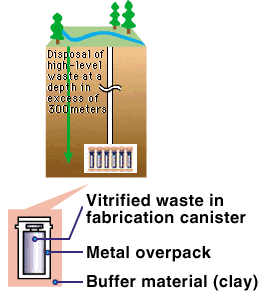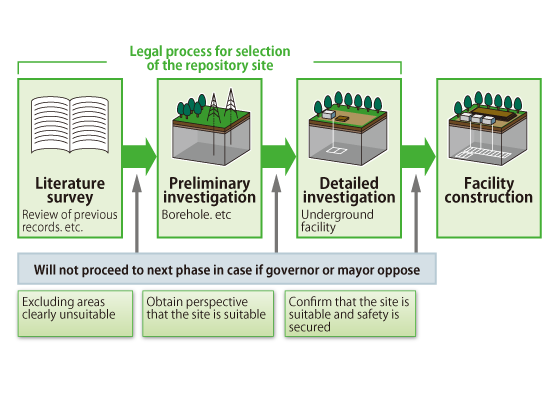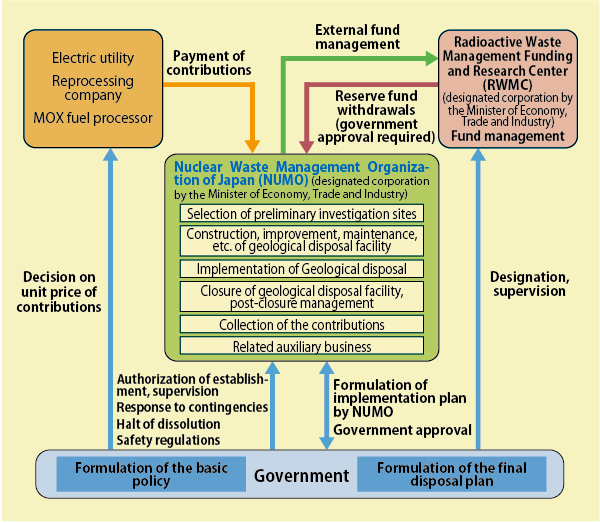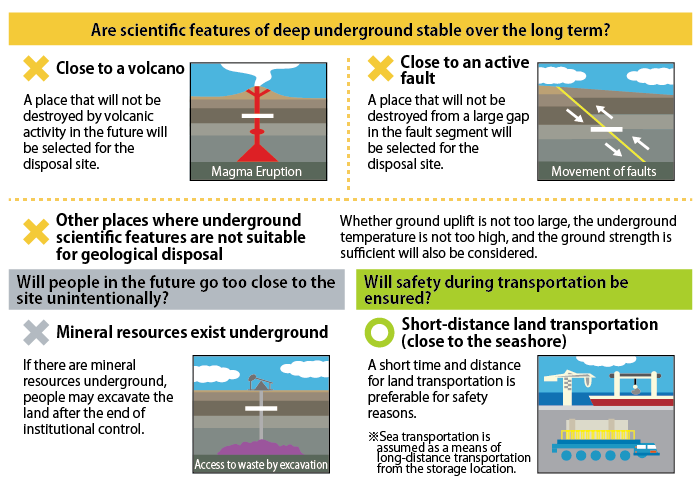In Japan, highly radioactive liquid waste arising from the reprocessing of spent fuel is solidified in a glass matrix. This is termed high-level waste (HLW).
As of March 31st 2024, the total volume of spent fuel that had been produced is equivalent to around 27,000 canisters of vitrified waste. The number of canisters being stored in Japan is 2,505.
In Japan, spent fuel is reprocessed to extract uranium and plutonium for re-use in the nuclear fuel cycle. The remaining highly active liquid waste has no further use. It is immobilized in a glass matrix which is surrounded by a stainless steel fabrication canister. Internationally, countries such as Sweden have opted for direct disposal of spent fuel. In such cases, the concept of geological disposal is also applied.
Following a period of interim storage to allow cooling, the vitrified high-level waste will be emplaced in a deep engineering repository. High-level waste will be disposed of in a stable geological formation at a depth of more than 300 meters. The vitrified waste in fabrication canisters will be encapsulated in strong metal containers (overpacks) and, once emplaced in the repository, will be surrounded by a clay buffer material. The canisters, overpacks and clay buffer material are referred to as the engineered barrier system. The geological environment, which isolates the waste for long time periods, is termed the natural barrier. The multibarrier system used for safe waste disposal is a combination of engineered and natural barrier. Research and development on the multibarrier system will continue with a view to building confidence in this concept.

At present, international consensus is that geological disposal is the best means of ensuring the long-term safety of waste disposal, Japan's strategy is thus in line with this consensus. The Nuclear Safety Commission of Japan is presently discussing safety regulations, which will be embodied in separate legislation. Waste disposal will have to comply with these regulations.
The facility consists of surface and underground structures. In the surface facility, vitrified waste is encapsulated in overpacks
and buffer material is produced. The underground facility is constructed in stable bedrock deeper than 300 m underground.
It is used to dispose of over 40,000 vitrified waste overpacks and 19,000 m3 of low-level radioactive waste for geological disposal (TRU waste). For reference, when constructing a geological facility in crystalline rock at a depth of 1,000m, the site area is expected to be about 1 to 2 km2 for the surface facility and about 6 to 10 km2 for the underground facility.
The selection of the geological disposal site will be conducted according to three stages of site investigation. These are the literature review, preliminary investigation, and detailed investigation, as defined by law. The sites deemed suitable for the disposal facility will be narrowed down accordingly. While proceeding with construction of the disposal facility at the selected site, some operations such as loading, placing, and backfilling of high-level radioactive waste will be performed simultaneously.
Finally, all tunnels will be backfilled and the site will be closed. The impact on the surrounding environment will be continuously monitored during this process, and ongoing monitoring will be considered as necessary after the closure of the site. Transparency, objectivity, and fairness will be ensured during the site investigation and selection process, and the voices of local residents will be reflected accordingly.

The total cost of final disposal of vitrified waste and TRU waste is estimated at 4.0 trillion yen, according to 2020 reference materials from the Agency for Natural Resources and Energy (ANRE).
This includes costs such as technology development, surveys, land acquisition, design and construction, operation, dismantling and closure, monitoring, and project management.

To ensure long-term safety, the disposal site will be carefully selected to avoid impacts from volcanic activity and active faults,
and engineered with barriers to provide a sufficient containment system. The timeline for ensuring the safety of geological
disposal is very long, at least tens of thousands of years, and cannot be confirmed directly through experiments.
Computer simulations will be used to assess impacts on people and the environment and ensure that the standards set by
safety regulators are met. These methods are also employed in other countries, and creating the scenarios and development
and verification of simulations will be carried out in cooperation with international partners.

Although the frequency of earthquakes varies depending on the region in Japan, there is no place that is completely safe from earthquakes. Therefore, each individual site will be investigated and evaluated in detail for earthquake risk in the site selection review, and the facility will be designed to withstand the expected earthquake intensity. In addition, the intensity felt underground during an earthquake is one-third to one-fifth of the intensity felt on the surface. Because the buffer material fills in the gaps between the overpack and the host rock, after being placed deep underground, the waste would shake along with the surrounding host rock during an earthquake. It is very unlikely that the waste would get destroyed due to an earthquake.
For the above reasons, safe geological disposal is considered possible even in earthquake-prone Japan.
The Agency for Natural Resources and Energy (ANRE) of the Ministry of Economy, Trade and Industry published the Nationwide Map of Scientific Features for Geological Disposal in July 2017.
The map shows the regional scientific features related to geological disposal, such as the impacts of natural phenomena, e.g., volcanic activity and fault activity, and the strength and temperature conditions deep underground, as a national map objectively compiled based on set requirements and standards. With this map, we can get a general overview of what types of scientific features need to be taken into consideration when selecting a geological disposal site, and how those scientific features are distributed throughout Japan.




